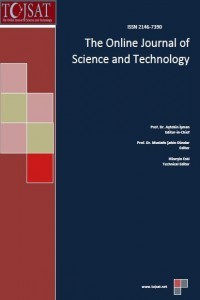MODELING AND RHEOLOGICAL CHARACTERIZATION OF SLUDGE BASED DRILLING OIL
MODELING AND RHEOLOGICAL CHARACTERIZATION OF SLUDGE BASED DRILLING OIL
drilling mud, rheology plastic viscosity, yield value,
___
- Bingham, E.C., (1922). Fluidity and plasticity Mc Graw.
- Coussot P., Nguyen Q. D. et al.(2002), “Viscosity bifurcation in thixotropic, yielding fluids” in journal Rheology. 46 pp. 573-589.
- Coussot P. (2009). La vie secrète des fluides à seuil, in 44ème colloque annuel du groupe français de Rhéologie, Strasbourg, France.
- Clain X, Chevalier C, Canou J, Dupla J-C, Coussot P. (2009). Injection de fluide d’Herschel-Bulkley en milieu poreux in 44ème colloque annuel du groupe français de Rhéologie, Strasbourg, France.
- Fadairo A. S., Tozunku K., S., Kadiri T., M., Solarin T., Falode O., A., (2012), Investigating the Effect of Electrolytes and Temperature on Rheological Properties of Jatropha Oil Based Mud, Nigeria Annual International Conference and Exhibition, 6-8 August 2012, Lagos, Nigeria, p:11.
- Herschel, W.H. abs Bulkley 1926). Konsistenzmessungen von Gummi-Benzollosungen. Kolloid Z. 39: 290-300.
- Krieger I. M. (1989), "L'écoulement plastique et le rhéomètre rotatif à plateaux parallèles", Cahiers de Rhéologie, VIII, 61- France.
- Maglione R., Robotti G., Romagnoli R., (2000) In-Situ Rheological Characterization of Drilling Mud, SPE Journal, Volume 5, Number 4, p 377-386
- Mellak A. ; Baudeau Ph. (1994). "Etudes physico-chimiques sur des coulis de ciment saumurés et microsilicés appropriés aux formations salifères", Annales de l'ITBTP, 526, Paris.
- Mellak A. (2004). Caractérisation d’un ciment destiné aux zones à pertes et modélisation de son caractère thixotrope in 39ème Colloque du Groupe Français de Rhéologie (GFR), A15 (2004), Mulhouse, France.
- Mellak A. (2007). Caractérisations rhéologiques des coulis de ciment spécifiques aux formations salifères in Lebanese Science Journal (CNRS), vol. 8, n°2, pp115-120.
- Quemada D, (1977). Rheol. Acta, 16, 82.
- Nguyen V. H. (2006). Flow of Hershel-Bulkley fluids through the Marsh cone in Journal Non Newtonian Fluid Mechanics, 139, 128 -134
- Osisanya S.O. (2001). Non Newtonian fluid mechanics, Lecture notes, School of petroleum and geological engineering, Algerian Graduate program Spring, the University Oklahoma USA.
- Son T., Ovarlez G., Château X., (2009). Comportement rhéologique de suspension bidisperses de particules dans un fluide à seuil in 44ème colloque annuel du groupe français de Rhéologie, Strasbourg, France
- ISSN: 2146-7390
- Başlangıç: 2011
- Yayıncı: The association of science, education and technology
Transverse Thermal Dispersion in Porous Media Under Oscillating Flow
Mehmet Turgay PAMUK, Mustafa ÖZDEMİR
Temperature Control in an Industrial SO2 Converter
Chaouki Bendjaoouahdou, Mohamed Hadi Bendjaouahdou
Noraida A. Ghani, Mohd. Kamal Mohd. Nawawi, Ruzelan Khalid, Luthful A. KAWSAR, Anton A. Kamil, Adli Mustafa
Emissions trading in financial statements: new Italian accounting standards
MODELING AND RHEOLOGICAL CHARACTERIZATION OF SLUDGE BASED DRILLING OIL
Abderrahmane MELLAK, Khaled BENYOUNES
Disaster Management and Disaster Preparedness: Examples of Practices in California and Turkey
